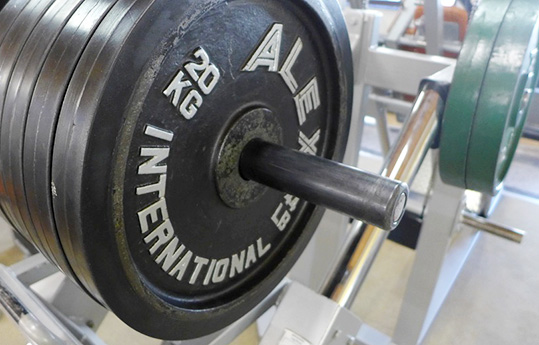Why strength training is important for all athletes
Strength training has become such an integral part of an athlete’s training regimen over the past several decades that you would assume it is universally accepted as standard operating procedure. However, judging from some of the correspondence I receive from coaches around the country, there still appears to be a fairly large contingent of well-meaning coaches who are recipients of push-back regarding strength training’s efficacy and overall benefits.
 Whether the concerns stem from uninformed parents/guardians, misguided coaches or athletic directors, or antiquated gender stereotyping and misconceptions, strength training still receives a bad rap in some small, restricted circles.
Whether the concerns stem from uninformed parents/guardians, misguided coaches or athletic directors, or antiquated gender stereotyping and misconceptions, strength training still receives a bad rap in some small, restricted circles.
Think of them as the “magnificent seven” reasons to strength train.
1. It helps reduce the incidence or severity of injury.
Injuries are inevitable in sport competition. The cumulative effect of the constant, inherent pounding on the body eventually takes its toll. However, a comprehensive, well-organized, properly administered and year-round strength training program results in musculo-tendon units that are more resilient to the stresses and impact forces sustained in athletic activities.
When you think of these structures as “shock absorbers” and joint stabilizers, the need for continued strengthening becomes clear. An extremely important point of emphasis here is that this benefit holds true for both male and female athletes. Numerous studies indicate that females show relatively similar gains in muscle size (i.e., pound for pound) and strength as males after several weeks of strength training. This increased strength is just as important in injury deterrence for females as it is for males.
The combination of muscle and connective tissue strength and pliability derived from strength training is crucial in dissipating the aforementioned forces that are so prevalent in both practices and games. Additionally, stronger muscles and connective tissue tend to mend better and at a faster rate when injuries are incurred.
The bottom line is if for no other reason, these polestar factors on injury deterrence make strength training a requisite for all athletes.
2. Improvements in overall flexibility.
Full-range strength training, like that which focuses on movement paths that complete the biomechanically correct concentric (raising phase) and eccentric (lowering phase) functions of the targeted area, will have an enhancing effect on mobility and flexibility of that structure. Keep in mind that muscles work in pairs, and while one compartment of a joint is shortened (contracted), the opposite compartment is lengthened (stretched). Hence, taking the time and effort to work a given strength training set in a focused concentric and eccentric manner pays dividends in long-term flexibility improvements.
Do not fall for the antiquated notions that strength training results in stiff, robotic, clumsy, unskilled athletes. On the contrary, you will find that your athletes demonstrate more power, speed, quickness and athleticism as the result of progressive resistance training program than ever before.
3. Healthy, efficient body composition.
This refers to the relative amount of lean tissue (i.e., muscle, connective tissue and bone) versus fat tissue in our bodies. When we combine a structured, well-designed format of strength training, interval training (via running and other cardiovascular enhancing activities), proper nutrition and rest, we can attain the most productive expression of lean to fat body composition possible. And since muscle is the driving force (literally and figuratively) behind all of the body’s movements, increasing its cross-sectional areas with resistance training while concomitantly decreasing fat tissue improves overall athletic efficiency.
Power, speed and quickness can be heightened exponentially with an increase in lean weight, even without a dramatic loss in body fat. More importantly, and in light of the obesity crisis this nation is mired in with the youth population, strength training can be a viable and result-producing component when it is included as a corrective measure.
4. Increased resting metabolism.
Muscle is a very active tissue. In essence, every pound of new muscle burns around 30-40 calories a day for tissue maintenance while the body is at rest. Approximately three pounds of new muscle can raise your resting metabolic rate by about seven percent. The benefits of this occurrence are obvious; the body becomes an efficient, calorie-burning machine that factors into weight control and plays a paramount role in keeping body fat in check.
So, even when you are resting and not working hard in the weight room, your thermoregulatory system is so fine-tuned that it works overtime in assisting your body in maintaining your weight goal.
5. Packing the power.
Power is the product of muscle force and movement speed. The combination of strength training and specific skill work — relative to one’s sport and position — has a positive influence on both of these parameters. Larger, stronger muscle fibers (especially the “fast twitch” variety) result in a higher rate and level of overall muscle force production, which results in the ability to demonstrate pronounced power output in designated athletic skills.
The caveats are these: The resistance training must be progressive in nature, and the skill work must be identical to what is expected in practice and competition. When both components are working in concert, the result is a highly efficient, explosive athlete.
6. Increased bone mineral density.
Strength training places stress on the body, but it is a good stress when properly administered. We already touched on the positive benefits to muscle and connective tissue. In terms of bone material, progressive resistance training heightens protein and mineral content. Significant improvements in bone density have been show to occur after a mere four months of dedicated strength training.
Increased bone density results in stronger bones that are more resilient to injury. This is an especially important variable for females, as their risk of osteoporosis expands dramatically as they grow older. Strong muscles and bones through resistance training — that’s a winning combination.
7. Improved glucose metabolism.
We know that poor glucose metabolism is associated with diabetes. Strength training is an effective means of improving glucose metabolism, and has been shown to increase glucose uptake close to 25 percent after a mere few months of consistent exercise.
Increases in muscle cross-section and overall lean body mass appear to be associated with improved glucose and insulin homeostasis. Some researchers even suggest that strength training should be a recommended approach for helping to prevent and manage type two diabetes and other metabolic disorders. There is also research data on some beneficial effects of strength training on blood lipid profiles (i.e., increasing HDL, and lowering LDL and triglycerides), though it is believed that genetic factors may determine the degree of these positive changes.
Strength training is, unquestionably, one of the most effective avenues available to us for enhancing numerous aspects of physical health and performance-related variables. In addition to the positive physical outcomes mentioned, there also is evidence of mental health benefits including decreased symptoms of depression, increased self-esteem and self-concept, and improved cognitive capabilities.
With all of those key ingredients to athletic success and an improved quality of life in place, the case for engaging in a safely administered, comprehensive, year-round, progressive strength training program is on rock-solid footing.
Reference
Westcott, W.L., Resistance Training is Medicine: Effects of Strength Training on Health, Current Sports Medicine Reports, July/August, 2012; 11:4.
To contact Ken Mannie about this topic or anything else you’ve read in Powerline, send him an email at mannie@ath.msu.edu.
4 thoughts on “Why strength training is important for all athletes”
Leave a Reply
You must be logged in to post a comment.




That makes sense that strength training strengthens musculo-tendon connections. Athletes must find that valuable to avoid injury. Muscle also raises your resting metabolic rate.
It’s interesting how you said that an athletic strength training program could help an individual develop stronger bones. This really seems like something that most people should do. Rather than leaving the strength training to athletes, it would be good for normal people to do this kind of thing as well.
It’s nice reading such an article on this topic. Only a few recognizes the importance and benefits of Strength Training. Even if your not an athlete or into any sports, just for fitness purposes, strength training is good.